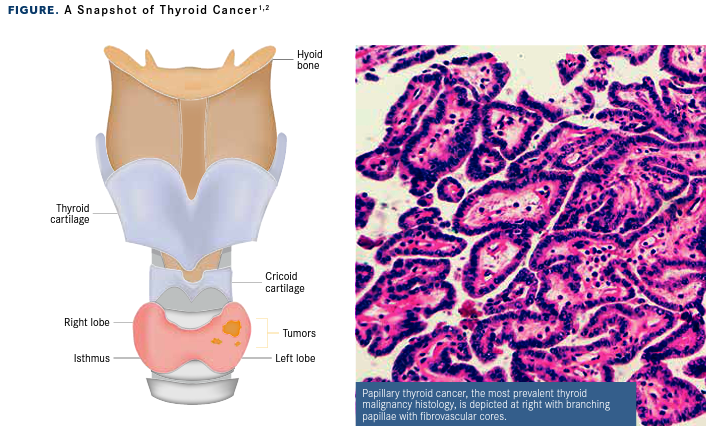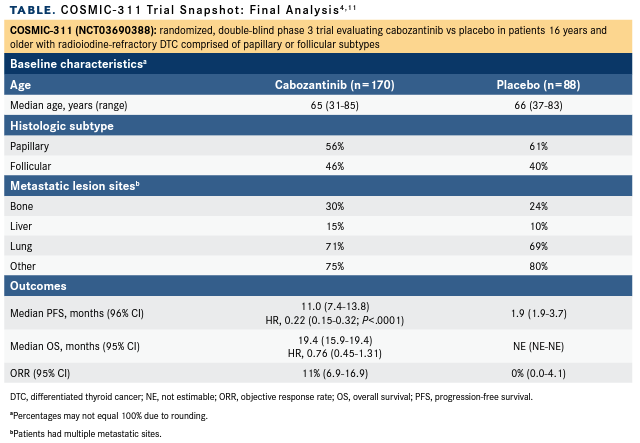Publication
Article
Targeted Treatment Boom Reshapes Differentiated Thyroid Cancer Landscape
Author(s):
Marcia S. Brose, MD, PhD, FASCO, and a panel of thyroid cancer experts share their insights into the evolving treatment landscape, including the use of VEGF receptor inhibitors and some of the precision medicine treatments now identified for molecularly selected subsets of patients with differentiated thyroid cancer, such as BRAF, RET, and TRK inhibitors.
Marcia S. Brose, MD, PhD, FASCO

Differentiated thyroid cancer (DTC) makes up approximately 95% of all thyroid cancers and is becoming more prevalent worldwide.1 A decade ago, treatment options for DTC were limited but today a plethora of targeted treatments are available. “There are not a lot of cancer types [in which] such great research, collaboration, and advancements have happened,” Marcia S. Brose, MD, PhD, FASCO, said during a recent OncLive Peer Exchange® program.
Brose was among a panel of thyroid cancer experts who shared their insights into the evolving DTC treatment landscape. They reviewed the use of VEGF receptor (VEGFR) inhibitors and some of the precision medicine treatments now identified for molecularly selected subsets of patients with DTC, such as BRAF, RET, and TRK inhibitors.
The DTC classification includes papillary thyroid cancer (PTC), follicular thyroid cancer, and Hürthle cell cancer (FIGURE1,2).1 The 2 main lineages, papillary and follicular, have differences in epidemiological profiles and clinical course, noted Giuseppe Barbesino, MD. “Papillary thyroid cancer is the most common type. It is seen across [all] ages with mostly nodal metastasis, occasionally other organs,” he said. “The follicular type…tends to metastasize to the bone, but the lungs can also be involved.”

VEGFR Inhibitors
Although initial therapy for localized DTC is often effective, tumor recurrences have been observed in up to 30% of patients.2 During the past 10 years, kinase inhibitors have been introduced for patients with metastatic or recurrent DTC, starting with agents directed at the angiogenic pathway.
“Thyroid cancers are very vascular tumors. They respond very well to VEGFR inhibitors,” Maria E. Cabanillas, MD, said. For this reason, anti-VEGFR inhibitors have become a mainstay of treatment for thyroid cancer across histological subtypes. The panelists focused on 3 VEGFR inhibitors that the FDA has approved for patients with radioactive iodinerefractory DTC: sorafenib (Nexavar) and lenvatinib (Lenvima), which are approved as first-line treatments, and cabozantinib (Cabometyx), which is approved as a second-line treatment.3 In addition to VEGFRs, each of these drugs inhibits other kinases associated with angiogenesis, tumor growth, and cancer progression.4,5
Demonstrating an overall survival benefit in pivotal VEGFR trials for sorafenib and lenvatinib has proved challenging because patients from the placebo arms were permitted to transition to the study drug, noted Lori J. Wirth, MD, who served as moderator of the Peer Exchange program. “Patients [receiving] placebo when they had disease progression were allowed to cross over and receive the active drug and the majority of patients all received the active drug…so that could negate an overall survival benefit.”
Sorafenib
In 2013, sorafenib became the first VEGFR inhibitor approved by the FDA for patients with radioactive iodine–refractory locally recurrent or metastatic DTC, Brose said.3 The FDA’s approval was based on data from the phase 3 DECISION trial (NCT00984282), in which investigators randomly assigned 417 patients 1:1 to receive sorafenib (n = 207) or placebo (n = 210).5 Patients receiving placebo who progressed were allowed to cross over to open-label sorafenib. The primary end point was progression-free survival (PFS) by central independent blinded review.
Sorafenib therapy resulted in significantly improved PFS vs placebo, with a median PFS of 10.8 months (95% CI, 9.1-12.9) vs 5.8 months (95% CI, 5.3-7.8), respectively (HR, 0.59; 95% CI, 0.45-0.76; P < . 0001). Improvement in PFS with sorafenib was seen regardless of whether patients’ tumors harbored BRAF or RAS family mutations. There was no statistically significant difference in the secondary end point of OS between the treatment arms, and the median OS was not reached in either arm.6.7 In the final OS analysis, which adjusted for crossover, the data suggested that the true OS treatment effect with sorafenib was larger than observed in the intention-to-treat (ITT) analysis.8
Lenvatinib
The FDA approved lenvatinib for radioactive iodine–refractory locally advanced or metastatic DTC in 2015 based on findings from the phase 3 SELECT study (NCT01321554), whose investigators randomly assigned 392 patients with progressive radioiodine-refractory DTC 2:1 to lenvatinib (n = 261) or placebo (n = 131).3,5,9 As in the DECISION study, patients who progressed on placebo could receive open-label lenvatinib. The primary end point was PFS, with secondary end points including response rate, OS, and safety.
The median PFS was 18.3 months (95% CI, 15.1-not estimable [NE]) in the lenvatinib arm vs 3.6 months (95% CI, 2.2-3.7) in the placebo arm (HR, 0.21; 99% CI, 0.14-0.31; P < . 001).9 The response rate was 64.8% (n = 169) in the lenvatinib arm, with 4 complete responses (CRs) and 165 partial responses (PRs), compared with a response rate of 1.5% (n = 2) in 131 patients in the placebo arm, with 2 PRs (odds ratio [OR], 28.87; 95% CI, 12.46-66.86; P < . 001). The median OS was not reached in either arm.
“I think many people have switched to make lenvatinib their first-line therapy based on these really strong results from the SELECT trial,” Brose said.
Cabozantinib
Cabozantinib is the latest VEGFR inhibitor to be approved, in September 2021. The FDA approved the agent for adult and pediatric patients 12 years and older with locally advanced or metastatic DTC that has progressed following prior VEGFR-targeted therapy and who are ineligible for or refractory to radioactive iodine.10
Approval was based on data from the phase 3 COSMIC-311 trial (NCT03690388), in which investigators randomly assigned 187 patients 2:1 to cabozantinib (n = 125) or placebo (n = 62).4,11 All patients had been previously treated with sorafenib, lenvatinib, or both. Crossover to cabozantinib following progression on placebo was allowed. The primary end points were objective response rate (ORR) in the first 100 randomly assigned patients and PFS in all randomly assigned patients (ie, ITT population).
“That trial was halted early because it reached one of its primary end points after only 100 patients had been on study for 6 months. So at its f irst data analysis point, it reached its primary end point, and the data safety monitoring committee recommended it be stopped because it had already shown its efficacy,” Brose said.
As of data cutoff in February 2021, 258 patients had been randomly assigned in the ITT population, with 170 receiving cabozantinib and 88 receiving placebo. In the final analysis, which had a longer median follow-up of the ITT population than the preplanned interim analysis (10.1 months vs 6.2 months, respectively), the median PFS was 11.0 months (96% CI, 7.4-13.8) for cabozantinib compared with 1.9 months for placebo (95% CI, 1.9-3.7), which translated into a 78% reduction in risk of progression (HR, 0.22; 96% CI, 0.15-0.32; P < . 0001).11 The ORR was 11.0% (95% CI, 6.9%-16.9%) for cabozantinib vs 0% (95% CI, 0.0%-4.1%) for placebo (TABLE4,11).

“[The COSMIC-311] setting is very different from the first line and the SELECT and DECISION trials because [the COSMIC-311 patients] were rapidly progressing. It’s important for people to know that when things start to go badly and people have already been on sorafenib, lenvatinib, or both for a long time, many times the speed of the disease has really picked up,” Bose said. Subsequently, she said it is essential for clinicians to line up their next therapy at the first hint that a patient has multiple sites of disease that are progressing. If they have not prepared for this, she warned that the patient could decline so quickly that there would no longer be an opportunity to treat them, especially because some drugs can take weeks to obtain.
Managing Toxicities of Anti-VEGFR Therapy
Inhibition of the VEGF signaling pathway is associated with distinct adverse effects (AEs), some of which can be life threatening if proper precautions are not taken. “The toxicity profiles among these 3 [VEGFR inhibitors] are, I would say, comparable. It’s like a bouquet of flowers with the same flowers. Of course, no 2 bouquets are exactly alike, even if they have the same flowers,” Brose said.
She noted that VEGFR inhibitors are associated with varying degrees of hand-foot skin reactions, diarrhea, and hypertension. With lenvatinib, she said, hypertension is the most significant and worrisome AE initially, as it can happen very quickly. To prevent complications from this AE, she calls in prescriptions for antihypertensives before patients start treatment so they can take those therapies if their blood pressure exceeds 150/90 mm Hg, especially at a time when the clinic might be closed. Regarding the hand-foot skin reactions, she tells patients that taking ibuprofen can be helpful.
Brose emphasized the importance of educating patients about AEs associated with VEGFR inhibitors to ensure these events are caught early on, which minimizes risks and enables patients to remain on treatment. “Most adverse events don’t become grade 3 without being grade 1 or 2 first. And if you can intervene at that point, that can make a huge difference,” she said.
BRAF Inhibitors
Somatic BRAF V600E mutations have been observed in 37% to 50% of patients with PTC and are associated with aggressive tumor features and decreased uptake of radioiodine.2,12 Although BRAF inhibition has elicited antitumor activity against DTC in several clinical trials, the only FDA-approved therapy directed at this pathway is indicated for patients with anaplastic thyroid cancer (ATC)3, a rare and aggressive undifferentiated tumor type.2,5 In May 2018, the FDA approved the combination of dabrafenib (Tafinlar), a BRAF inhibitor, plus trametinib (Mekinist), a MEK inhibitor, for patients with locally advanced or metastatic ATC with a BRAF V600E mutation and no satisfactory locoregional treatment options.13
National Comprehensive Cancer Network guidelines note that BRAF inhibitors can be considered for patients with advanced BRAF-mutated PTC who are not candidates for radioiodine therapy, clinical trials, or other systemic therapy.2 During the Peer Exchange program, the panelists noted that BRAF inhibitory agents are particularly interesting because data from small studies have shown they can restore the ability of thyroid cancer cells to take up radioiodine (ie, a redifferentiation therapy), potentially reopening the door to radioiodine treatment.
Vemurafenib
Vemurafenib (Zelboraf) was the first BRAF inhibitor assessed in a clinical trial for thyroid cancer, Cabanillas said. It was evaluated in an open- label, nonrandomized, multicenter, phase 2 study (NCT01286753) that enrolled 51 patients with BRAF V600E–mutated metastatic or recurrent PTC. The participants included 26 who had never received VEGFR inhibitor therapy and 25 who previously had had such treatment.12 All patients received vemurafenib 960 mg orally twice daily. The primary end point was investigator-assessed best overall response in the VEGFR inhibitor– naïve cohort.
After a median duration of follow-up of 18.8 months in the VEGFR inhibitor–naïve cohort, the best overall response was PR, which investigators observed in 38.5% (n = 10) of patients (95% CI, 20.2-59.4).12 The median PFS was 18.2 months (95% CI, 15.5-29.3). In the previously treated cohort, after a median follow-up of 12.0 months, the best overall response was a PR in 27.3% of patients (6 of 22 patients, as 3 originally enrolled in this cohort were deemed ineligible or withdrew consent). The median PFS was 8.9 months (95% CI, 5.5-NE).
Cabanillas said that vemurafenib has a slightly different AE profile compared with dabrafenib, noting that it causes more issues with arthralgias and skin toxicities, including hand-foot skin reactions. She said vemurafenib also can cause squamous cell carcinomas of the skin and alopecia (usually just hair thinning), which are class effects of BRAF inhibitors. In the phase 2 trial, grade 3 or 4 AEs occurred in 65% or more of patients in both cohorts, with squamous cell carcinoma of the skin, lymphopenia, and increased γ-glutamyltransferase levels being the most common.
Dabrafenib
Dabrafenib was assessed in a randomized phase 2 trial (NCT01723202) that evaluated this agent alone and in combination with trametinib in 53 patients with BRAF-mutated PTC, 25% of whom had been previously treated with a multikinase inhibitor.14,15 In the study, 26 patients received dabrafenib monotherapy and 27 patients received dabrafenib plus trametinib. Crossover from monotherapy to combination therapy was allowed at the time of progression. The study’s primary end point was ORR, defined as PRs plus minor responses (ie, 20%-29% decrease in the sum of diameters of target lesions).
In the monotherapy arm, 11 of 22 evaluable patients responded, including 10 with PRs and 1 with a minor response, for an ORR of 50%. In the combination arm, 13 of 24 assessable patients responded, including 9 with PRs and 4 with minor responses, for an ORR of 54%. The median PFS was 11.4 months (95% CI, 3.8-not reached) among those who received monotherapy and 15.1 months (95% CI, 11.7-not reached) for those treated with the combination.14,15
“The number one problem that we have with dabrafenib is fever…; [it] tends to go away after about 2 or 3 months [in most patients] but it is difficult to manage in some patients,” Cabanillas said. She noted that some other AEs associated with dabrafenib include anemia, fatigue, nausea, skin disorders, and alopecia.
Use in Clinical Practice
Although VEGFR inhibitors are the recommended FDA-approved first-line treatments for locally advanced or metastatic radioiodine-refractory DTC, Cabanillas said that she will often start appropriate patients on a BRAF inhibitor. She favors this off-label approach because the toxicities associated with VEGFR inhibitors can be difficult for some patients to tolerate, particularly those who are older.
“When I think about treating systemically, I’m thinking about that marathon that we’re starting. Yes, I’ll get more partial responses with lenvatinib, but in terms of how long we’re going to have a response or stability, that’s really what’s going on in my mind—how can we get the most out of every single drug,” she said. She explained that if she starts a patient on a VEGFR inhibitor and they lose a significant amount of weight while on treatment and become debilitated, they may no longer be able to receive a second-line treatment, whereas if she first starts them on a BRAF inhibitor, they might be in better shape to start the VEGFR inhibitor when they progress.
Naifa L. Busaidy, MD, FACP, FACE, who like Cabanillas practices at The University of Texas MD Anderson Cancer Center, concurred. She said the general practice at their institution is to obtain biomarker testing and then proceed with whatever selective therapy is appropriate in the first line. “It doesn’t mean it’s necessarily the right thing to do, but if you’re worried about [getting] the anti-VEGF [agent] in the second line, now we have an official indication [with cabozantinib],” she said.
RET and TRK Inhibitors
RET and NTRK fusions are less frequent actionable targets that are mostly found in patients with PTC. “We’re going to see [RET fusions] in about 8% to 10% of PTCs, whereas NTRK fusions we see in about 3%,” Cabanillas said. She discussed 2 RET inhibitors, selpercatinib (Retevmo) and pralsetinib (Gavreto), and 2 TRK inhibitors (kinases encoded by NTRK genes), larotrectinib (Vitrakvi) and entrectinib (Rozlytrek), that the FDA has approved.
Selpercatinib
The FDA granted accelerated approvals for selpercatinib, a selective RET inhibitor, for adult and pediatric patients (≥ 12 years) with RET fusion–positive, radioiodine-refractory advanced or metastatic thyroid cancer, adult and pediatric patients with RET-mutant medullary thyroid cancer (MTC), and adults with RET fusion– positive non–small cell lung cancer (NSCLC).16
The RET fusion–positive thyroid cancer indication is based on findings from the phase 1/2 LIBRETTO-001 trial (NCT03157128), which included 19 patients with previously treated RET fusion–positive thyroid cancer. Among these were 13 patients with PTC, 3 with poorly differentiated tumors, 1 with Hürthle cell carcinoma, and 2 with ATS. Patients with RET-mutant MTC and RET fusion–positive NSCLC were enrolled in separate cohorts. After the dose-escalation portion of the trial, patients received selpercatinib orally at 160 mg twice daily.17
In the RET fusion–positive thyroid cancer cohort, the ORR by independent review was 79% (95% CI, 54%-94%), including 1 CR (5%) and 14 PRs (74%).17 After a median follow-up of 13.7 months, 64% (95% CI, 37%-82%) of patients were progression free at 1 year. All patients included in the study had been previously treated with 1 or more VEGFR inhibitors and had tumors refractory to radioiodine, other than participants with ATS, a subtype for which radioiodine is not used.
Overall, treatment was well tolerated. The discontinuation rate with selpercatinib for treatment-emergent AEs was only 2%, Cabanillas said, noting that this was for the entire study population of 531 patients. In those with thyroid cancer, the most common AEs of grade 3 or worse severity included hypertension, increased liver enzymes, hyponatremia, and diarrhea.17
Pralsetinib
Pralsetinib has gained accelerated approvals from the FDA for patients 12 years and older with advanced or metastatic RET fusion–positive thyroid cancer who require systemic therapy and are radioiodine-refractory (if such therapy is appropriate), as well as for adult and pediatric patients with advanced or metastatic RET-mutant MTC and adults with RET fusion–positive NSCLC.18 Its safety and efficacy were established in the phase 1/2 ARROW trial (NCT03037385) in patients with locally advanced or metastatic RET-altered solid tumors, including 20 patients with RET fusion–positive thyroid cancer.19 Among the 9 participants who were evaluable for response, all of whom had PTC, the ORR was 89% (95% CI, 52%-100%), all PRs. Although the median PFS and OS were not reached, 81% of patients were progression free at 1 year and the estimated 1-year OS was 91%.18
“The adverse event profile is similar [to] but not really the same [as that of selpercatinib]. It’s interesting that pralsetinib tends to cause more anemia. [The investigators] also reported more musculoskeletal pain and constipation,” Cabanillas said. Like selpercatinib, pralsetinib was associated with hypertension and increased liver enzymes.19 Both agents can elevate liver enzymes, but Cabanillas has switched from one agent to the other when a patient develops this AE. “It’s been OK on the opposite drug, so that is worth trying,” she said. In the safety population of 142 patients with RET-altered thyroid cancer, the discontinuation rate with pralsetinib was 4%.
Larotrectinib and Entrectinib
Larotrectinib and entrectinib are both approved by the FDA for the treatment of solid tumors harboring NTRK gene fusions (also called TRK fusions), Cabanillas said. She noted that larotrectinib has the most data to support its use in DTC.
Cabanillas and colleagues presented longterm efficacy and safety data for larotrectinib in DTC at the 90th Annual Meeting of the American Thyroid Association in 2021. In an assessment of data from several trials, which included 21 evaluable patients with DTC, the ORR was 86% (95% CI, 64%-97%), which include 2 CRs.20 “There was no best response progression, so [these were] really stellar outcomes. The median follow-up time was 22 months, and with that, we had a median progression-free survival of 51 months, and overall survival was not reached. But at 2 years, 92% of patients were alive,” she said.
Additionally, no patients discontinued treatment because of AEs, Cabanillas noted. Higher-grade AEs included anemia and low lymphocyte counts. She also noted some dizziness and nausea but said that the dizziness tends to resolve as patients adjust to the therapy.
Regarding entrectinib, Cabanillas said that very little is known about the use of this agent in thyroid cancer. She noted that the only data thus far come from an integrated analysis of 54 patients with advanced or metastatic solid tumors harboring NTRK fusions, only 5 of whom had thyroid cancer, with their subtypes not specified.21 Among these patients, there was only 1 PR. “We think it’s probably a similar drug [to larotrectinib], but it does have other targets and so may lead to some off-target effects,” she said.
References
- Van Den Heede K, Tolley NS, Di Marco AN, Palazzo FF. Differentiated thyroid cancer: a health economic review. Cancers (Basel). 2021;13(9):2253. doi:10.3390/cancers13092253
- NCCN. Clinical Practice Guidelines in Oncology. Thyroid carcinoma, version 3.2021. Accessed March 15, 2022. https://bit.ly/3w5UpyX
- Thyroid cancer: types of treatment. American Society of Clinical Oncology. Updated November 23, 2021. Accessed March 15, 2022. https://bit.ly/3q8iXTX
- Brose MS, Robinson B, Sherman SI, et al. Cabozantinib for radioiodine-refractory differentiated thyroid cancer (COSMIC-311): a randomised, double-blind, placebo-controlled, phase 3 trial. Lancet Oncol. 2021;22(8):1126-1138. doi:10.1016/S1470-2045(21)00332-6
- Thyroid cancer treatment (adult) (PDQ)–health professional version. National Cancer Institute. Updated February 18, 2022. Accessed March 15, 2022. https://bit.ly/34I7XoU
- Brose MS, Nutting CM, Jarzab B, et al; DECISION Investigators. Sorafenib in radioactive iodine-refractory, locally advanced or metastatic differentiated thyroid cancer: a randomised, double-blind, phase 3 trial. Lancet Oncol. 2014;384(9940):319-328. doi:10.1016/S0140-6736(14)60421-9
- Nexavar. Prescribing information. Bayer HealthCare Pharmaceuticals Inc; 2020. Accessed March 15, 2022. https://bit.ly/37rjDxj
- Brose M, Jarzab B, Elisei R, et al. Final overall survival analysis of patients with locally advanced or metastatic radioactive iodine-refractory differentiated thyroid cancer (RAI-rDTC) treated with sorafenib in the phase 3 DECISION trial: an exploratory crossover adjustment analyses. Ann Oncol. 2016;27(suppl 6):VI329. https://doi.org/10.1093/annonc/mdw376.06
- Schlumberger M, Tahara M, Wirth LJ, et al. Lenvatinib versus placebo in radioiodine-refractory thyroid cancer. N Engl J Med. 2015;372(7):621-630. doi:10.1056/NEJMoa1406470
- FDA D.I.S.C.O. Burst Edition: FDA approval of Cabometyx (cabozantinib) for locally advanced or metastatic differentiated thyroid cancer. FDA. Updated September 30, 2021. Accessed March 12, 2022. https://bit.ly/34DckBL
- Capdevila J, Robinson B, Sherman SI, et al. Cabozantinib versus placebo in patients with radioiodine-refractory differentiated thyroid cancer who have progressed after prior VEGFR-targeted therapy: updated results from the phase III COSMIC-311 trial and prespecified subgroup analyses by prior therapy. Ann Oncol. 2021;32(suppl5):S1283-S1346. doi:10.1016/j.annonc.2021.08.2148
- Brose MS, Cabanillas ME, Cohen EEW, et al. Vemurafenib in patients with BRAF(V600E)-positive metastatic or unresectable papillary thyroid cancer refractory to radioactive iodine: a non-randomised, multicentre, open-label, phase 2 trial. Lancet Oncol. 2016;17(9):1272-1282. doi:10.1016/S1470-2045(16)30166-8
- FDA approves dabrafenib plus trametinib for anaplastic thyroid cancer with BRAF V600E mutation. FDA. May 4, 2018. Accessed March 15, 2022. https://bit.ly/3w9tUIQ
- Shah MH, Wei L, Wirth LJ, et al. Results of randomized phase II trial of dabrafenib versus dabrafenib plus trametinib in BRAF-mutated papillary thyroid carcinoma. J Clin Oncol. 2017;35(suppl 15):6022. doi:10.1200/JCO.2017.35.15_suppl.6022
- Pitoia F, Jerkovich F, Trimboli P, Smulever A. New approaches for patients with advanced radioiodine-refractory thyroid cancer. World J Clin Oncol. 2022;13(1):9-27.doi:10.5306/wjco.v13.i1.9
- Retevmo. Prescribing information. Lilly USA, LLC; 2021. Accessed March 16, 2021. https://bit.ly/3CKXyWe
- Wirth LJ, Sherman E, Robinson B, et al. Efficacy of selpercatinib in RET-altered thyroid cancers. N Engl J Med. 2020;383(9):825-835. doi:10.1056/NEJMoa2005651
- Gavreto. Prescribing information. Genentech, Inc; 2022. Accessed March 16, 2022. https://bit.ly/37vOIjn
- Subbiah V, Hu MI, Wirth LJ, et al. Pralsetinib for patients with advanced or metastatic RET-altered thyroid cancer (ARROW): a multi-cohort, open-label, registrational, phase 1/2 study. Lancet Diabetes Endocrinol. 2021;9(8):491-501. doi:10.1016/S2213-8587(21)00120-0
- Waguespack SG, Drilon A, Lin JJ, et al. Long‐term efficacy and safety of larotrectinib in patients with advanced TRK fusion‐positive thyroid carcinoma. Thyroid. 2021;31(suppl 1):Oral 15. doi:10.1089/thy.2021.29115.abstracts
- Doebele RC, Drilon A, Paz-Ares L, et al; Trial Investigators. Entrectinib in patients with advanced or metastatic NTRK fusion-positive solid tumours: integrated analysis of three phase 1-2 trials. Lancet Oncol. 2020;21(2):271-282. Published correction appears in Lancet Oncol. 2021;22(10):e428.doi:10.1016/S1470-2045(19)30691-6








